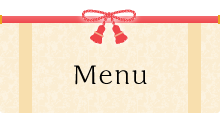Other Shrines | Sightseeing Spots | Miyajima Tourist Association
Hokoku Shrine (Senjokaku)
Designated as a National Important Cultural Property on August 29, 1910
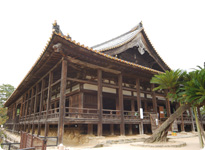
Hokoku Shrine is dedicated to the warlord Toyotomi Hideyoshi (one of the three unifiers of Japan in the 16th century) and his loyal aid Kato Kiyomasa. The reason for building this structure is clearly stated in a letter by Ankokuji Ekei, head monk of Ankokuji Temple. In 1587, Ekei asked Daiganji Temple, the temple in charge of construction and repair work in Miyajima including Itsukushima Shrine, to build a Buddhist library in which the chanting of Senbu-kyo sutras could be held every month. As there is no board ceiling or outer gate, it is believed that the construction of the building was not completed.
Originally, Amida Buddha and two subordinate Buddhist saints, Anan and Kasho-sonja, were enshrined in the Buddhist altar until the early Meiji era. Since that time, however, the altar has been used in Shinto rituals.
The building is called Senjokaku (Hall of One Thousand Tatami Mats), reflecting its standing as the largest structure on Miyajima Island. The shrine was a popular landmark in Miyajima where many people came to relax and cool themselves and to buy popular souvenirs such as tooth picks, and a variety of legends and traditions have been created here.
The fact that this structure, unique among the buildings belonging to Itsukushima Shrine, is unpainted and that its exact date of founding is recorded makes it a valuable gauge of the passage of time. The traces of weathering on its pillars and floor boards can be used to determine the approximate age of any other wooden structure on Miyajima.
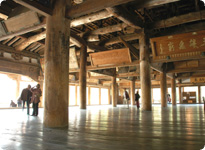
A piece of wood used as a measuring device in the reconstruction work of the O-Torii in 1873 hangs on a pillar under the floor of the south part of the shrine. Countless votive picture tablets that had been hanging on the walls of Itsukushima Shrine buildings until the mid Meiji era decorate the walls inside the hall.
The shrine did not yet exist at the time of the Battle of Itsukushima in 1555 when the Mori clan defeated the Sue clan to unify the Chugoku region. The headquarters of the Sue clan was located on this hill, which was then called To-no-oka (Pagoda Hill). Starting in the Meiji era, the hill was developed through the establishment of stone steps, among other additions.
Five-storied Pagoda
Designated as a National Important Cultural Property on April 7, 1900.
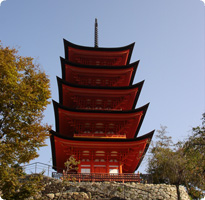
The Five-storied Pagoda was originally constructed in 1407, and it was restored in 1533. The main deity enshrined here is the Buddha of Medicine, accompanied by the Buddhist saints Fugen and Monju. The Buddhist images symbolizing the deity and the saints were removed in the early Meiji era.
The pagoda as a whole was constructed in Japanese style as evidenced by the ornamental caps of the railing posts as well as in the placement of the rafters. However, Chinese influence can also be seen in such parts as the top of the wooden pillars supporting the eaves, as well as in the tails of the rafters. Elaborate Giboshi decorations (decorations resembling leek flowers) are found on the railing posts of the first story, while Gyaku-ren and Kaika-ren decorations (resembling lotus flowers) are placed on the railing posts from the second story to the fifth. When major repair work was carried out in 1945, the structure was restored to its original style by coating it with red lacquer.
The interior of the pagoda is decorated with auspicious motifs such as a dragon, lotus flowers and the Shingon Hasso sutra painted on the ceiling, the Raigo Wall (the special name for the wall behind the Image of Buddha) and the rest of the interior wooden walls. One of the unique structural features is the central pillar of the pagoda, which extends to the peak of the roof only from the second story -- instead of the foundation. The names of donors have been carved on each of the sixteen pillars of the first story. Fourteen of these donors were women.
Tahoto (Two-storied Pagoda)
Designated as a National Important Cultural Property on August 2, 1901.

This pagoda is said to have been built in 1523. The Buddha of Medicine was worshipped here, but was moved to Daiganji Temple following the Meiji Restoration (1868). The name of the pagoda was changed to Hozan Shrine in 1880, and the deified warlord Kato Kiyomasa was then worshipped here, while the building itself came under the jurisdiction of Itsukushima Shrine. In 1918,the spirit of Kato Kiyomasa was moved to Toyokuni Shrine, where he is worshipped to this day.
The pagoda exterior is traditionally Japanese, but various architectural styles can be seen in the pagoda's details. For example, the Daibutsu (Great Buddha) style can be observed in the protruding ends, called kobushibana, of the horizontal bars that penetrate the structure's vertical pillars. Another example is the Zen style applied to the daiwa, which are the beams connecting the tops of the pillars.
The kaerumata (frog lap) is a wooden support that resembles two open legs of a frog. Its function is to carry the weight of the upper beams of the structure. There is one kaerumata in the center under each of the lower eaves. These highly decorative parts are engraved with Sanskrit characters.
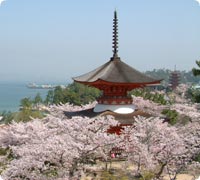
During Japan's Warring Period (1467-1568), a villa called Katsuyama-no-yakata was built near here. The famous warlord Ouchi stayed in the villa when visiting the island. It is said that Sue, the warlord who succeeded Ouchi, established his headquarters at this villa during the Battle of Itsukushima (1555).
A number of cherry trees have been planted around the pagoda, making it an idyllic spot for viewing cherry blossoms in spring. A trail wends its way from this spot to Komaga-bayashi along the ridge of the hill.
Kiyomori Shrine
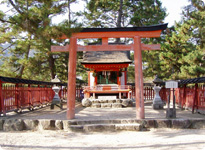
Kiyomori Shrine was built 770 years after the death of Taira-no-Kiyomori in 1954 to commemorate him and console his spirit.
Around March 20th, the anniversary of his death, the Kiyomori Festival is held.
Omoto Shrine
The main hall was designated as a National Important Cultural Property on February 18, 1949.
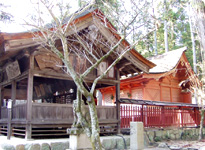
This shrine is dedicated to Kunitokotachi-no-mikoto, Oyamazumi-no-mikoto and other deities. It is unknown when the shrine was established, but it may have existed in 1443, as a wooden pole of the shrine bears ink letters mentioning that year. It was rebuilt in 1523.
The roof of the main hall is constructed in the "Omoto style," a unique style not seen anywhere else. In the construction, six layers of staggered shingles are layered three times, so that most of the roof is covered by eighteen layers of shingles.
The festival "Momotesai" is held here on January 20th.
The shrine contains many votive tablets with the words "Oshima-meguri" (Touring around the Island). "Oshima-meguri" is a local Shinto ritual popular since the Edo period. At Kangensai (Court Music Festival) , musicians on a sacred boat play court music near this shrine, and then head for Itsukushima Shrine. There are also stone lanterns standing on the shore of this shrine.









